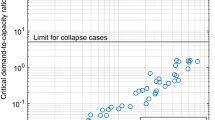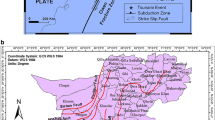Abstract
Determination of appropriate seismic demand is important for deriving reliable seismic forces for use in structural design and vulnerability assessment. Demand can be defined by either probabilistic or deterministic approaches depending on the use of the assessment. The use of probabilistic or deterministic approaches depends on the level of the assessment since deterministic can mostly be used for single structures whereas probabilistic for city or country level assessment. This paper presents demand characterization which is based on results of existing seismic hazard studies and local tectonic features around Islamabad–Rawalpindi region (study region) in Pakistan. Existing seismic zoning maps and recent probabilistic seismic hazard studies are reviewed, and the findings are used to quantify and compare the demand for a typical low-rise reinforced concrete building. As another option, deterministic demand is defined through spectra using suitable attenuation relationship which is assessed and validated using the Kashmir earthquake and other similar earthquakes data. Deterministic spectra for study region are generated by considering the critical local tectonic features. Federal Emergency Management Agency (FEMA 356) approach is used for smoothening of deterministic spectra, and the new spectral corner periods are calculated.
Similar content being viewed by others
Abbreviations
- BCP:
-
Building Code of Pakistan
- GSP:
-
Geological Survey of Pakistan
- GSHAP:
-
Geological Seismic Hazard Assessment Program
- MSSP:
-
Micro seismic Studies Program
- PAEC:
-
Pakistan Atomic Energy Commission
- PMD:
-
Pakistan Meteorological Department
- PSC:
-
Pakistan Seismic Code
- NESPAK:
-
National Engineering Services Pakistan
- UBC:
-
Uniform Building Code
References
Monalisa, M.; Khwaja, A.A.; Qasim Jan, M.; Yeats, R.S.; Hussain, A.; Khan, S.A.: New data on the Indus Kohistan seismic zone and its extension into the Hazara-Kashmir Syntaxis. NW Himalayas of Pakistan. J. Seismolog. 13(3), 339–361 (2009)
Zaman, S.; Ornthammarath, T.; Warnitchai, P.: Probabilistic seismic hazard maps for Pakistan. In: Proceedings of the 15th World Conference on Earthquake Engineering-WCEE, vol 1995 (2012), pp. 1–10
PMD-NORSAR: Seismic hazard analysis and zonation for Pakistan. Azad Jammu and Kashmir. Pakistan Meteorological Department (PMD), NORSAR (Norway) (2007)
Asian Development Bank and World Bank (ADB-WB).: Preliminary Damage and Needs Assessment. Prepared by Asian Development Bank and World Bank, Islamabad, November 12, 2005 (2005)
Micro Siesmic Studies Program (MSSP), Government of Pakistan (2005)
Mid-America Earthquake Center. University of Illinois at Urbana Champaign, Report No. 05–04 (2005).
Pakistan Seicmic Code PSC-86: Ministry of Housing and Works, Government of Pakistan. http://mohw.gov.pk/ (1986)
Geological Survey of Pakistan (GSP) Ministry of Petroleum and Natural Resources. Government of Pakistan. http://www.gsp.gov.pk/ (1988)
Pakistan Meteorological Department (PMD), Government of Pakistan. http://www.pmd.gov.pk/ (1999)
Monalisa, M.; Khwaja, A.A.; Jan, M.Q.: Seismic hazard assessment of the NW Himalayan fold-and-thrust belt, Pakistan, using probabilistic approach. J. Earthq. Eng. 11(2), 257–301 (2007)
NESPAK report: Revision/ updation of seismic code of Pakistan, Recommendation for preliminary seismic design parameters and criteria for seismic resistant design of buildings in Islamabad-Rawalpindi area (2006)
Building code of Pakistan (Seismic provisions—2007). Ministry of housing and works, Government of Pakistan. http://mohw.gov.pk/ (2007)
Khan, S.: An earthquake risk assessment framework for developing countries: Pakistan a case study. University of Sheffield (2010)
ASCE 4-98: Seismic analysis of safety related nuclear structures and commentary (2000)
Tabatabaiefar, H.R.; Fatahi, B.: Idealisation of soil–structure system to determine in-elastic. Soil Dyn. Earthq. Eng. 66(2014), 339–351 (2014). https://doi.org/10.1016/j.soildyn.2014.08.007
Hokmabadi, A.S.; Fatahi, B.: Influence of foundation type on seismic performance of buildings considering soil–structure interaction. Int. J. Struct. Stab. Dyn. 16(2016), 1550043 (2016). https://doi.org/10.1142/S0219455415500431
Nguyen, V.; Fatahi, B.; Hokmabadi, A.S.: Influence of size and load-bearing mechanism of piles on seismic performance of buildings considering soil–pile–structure–interaction. ASCE Int. J. Geomech. (2017). https://doi.org/10.1061/(ASCE)GM.1943-5622.0000869
Fatahi, B.; Tabatabaiefar, H.: R: Fully non-linear versus equivalent linear computation method for seismic analysis of mid rise buildings on soft soil. ASCE Int. J. Geomech. 14(4), 04014016 (2014)
Monalisa, M.; Khan, S.A.; Khwaja, A.A.: Focal mechanism study of north Potwar deformed zone, Pakistan. Earthq. Sci. 17(3), 255 (2004)
UBC: Uniform Building Code. In. (1997)
Theodulidis, N.P.; Papazachos, B.C.: Dependence of strong ground motion on magnitude-distance, site geology and macroseismic intensity for shallow earthquakes in Greece: I, peak horizontal acceleration, velocity and displacement. J. Soil Dyn. Earthq. Eng. 11, 387–402 (1992)
United nation global seismic hazard assessment program (GSHAP/USGS) (1992) to (1999). Reports and maps of world seismic hazard. United States Geological Survey, Denver, Colorado. http://www.seismo.ethz.ch/. GSHAP (1999)
Monalisa, M.: Seismic hazard assessment of NW himalayan fold and thrust belt, Pakistan. Ph.D. thesis, Qauid E Azam International University (2005)
UBC: Uniform Building Code. In. (1985)
American Society of Civil Engineers: minimum design loads for buildings and other structures. ASCE 7-05, Reston, VA (2005)
Building Seismic Safety Council (BSSC): NEHRP recommended provisions for the development of seismic regulations for new buildings (FEMA 450). Washington, D.C. (2003)
EC8: Design of structures for earthquake resistance—part 1 general rules, seismic actions and rules for buildings (BS EN 1998-1:2004). In. (2004)
Campbell, K.W.: Empirical near-source attenuation relationships for horizontal and vertical components of peak ground acceleration, peak ground velocity, and pseudo-absolute acceleration response spectra. Seismol. Res. Lett. 68(1), 154–179 (1997)
Boore, D.M.; Joyner, W.B.; Fumal, T.E.: Equations for estimating horizontal response spectra and peak acceleration from western North American earthquakes: a summary of recent work. Seismol. Res. Lett. 68(1), 128–153 (1997)
Sadigh, K.; Chang, C.-Y.; Egan, J.; Makdisi, F.; Youngs, R.: Attenuation relationships for shallow crustal earthquakes based on California strong motion data. Seismol. Res. Lett. 68(1), 180–189 (1997)
Ambraseys, N.; Douglas, J.; Sarma, S.; Smit, P.: Equations for the estimation of strong ground motions from shallow crustal earthquakes using data from Europe and the Middle East: horizontal peak ground acceleration and spectral acceleration. Bull. Earthq. Eng. 3(1), 1–53 (2005)
Wells, D.L.; Coppersmith, K.J.: New empirical relationships among magnitude, rupture length, rupture width, rupture area, and surface displacement. Bull. Seismol. Soc. Am. 84(4), 974–1002 (1994)
Mohraz, B.: Influences of the magnitude of the earthquake and the duration of strong motion on earthquake response spectra. In: Proceedings of the Central American Conference on Earthquake Engineering, San Salvadore (1978)
Hamedi, F. ; Tehranizadeh, M.: Influence of effective duration of strong motion on elastic response spectra. In: Proceedings of 12th World Conference on Earthquake Engineering (2000), paper no. 1234, pp 1–6
BSSC, P.: Commentary for the seismic rehabilitation of buildings (FEMA-356). Federal Emergency Management Agency (2000)
FEMA356: Prestandard and commentary for the seismic rehabilitation of buildings. Federal Emergency Management Agency, Washington DC (2000)
Hussain, A.; Yeats, R.S.: MonaLisa.: Geological setting of the 8 October 2005 Kashmir earthquake. J. Seismol. 13(3), 315–325 (2008)
Author information
Authors and Affiliations
Corresponding author
Rights and permissions
About this article
Cite this article
Ahmad, S., Pilakoutas, K., Khan, Q.U.Z. et al. Seismic Demand for Low-Rise Reinforced Concrete Buildings of Islamabad–Rawalpindi Region (Pakistan). Arab J Sci Eng 43, 5101–5117 (2018). https://doi.org/10.1007/s13369-017-2924-1
Received:
Accepted:
Published:
Issue Date:
DOI: https://doi.org/10.1007/s13369-017-2924-1




